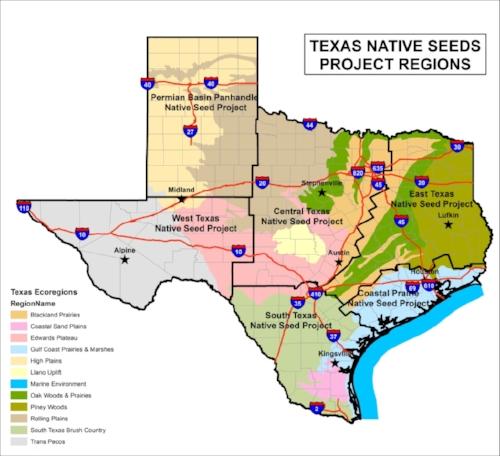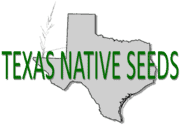Texas Native Seeds Project Regions

Douglass King Seeds is a sponsor and producer of certified South Texas Native Plant varieties. We are proud to support and work with the South Texas Natives and Texas Natives Seeds projects at the Caesar Kleberg Wildlife Research Institute.

This EcoMap was provided by Texas Native Seed Project in Texas A&M Kingsville.
An ecoregion is an area of land that is similar in habitat, geology, soil, and vegetation. Ecoregions are large, general groupings and there can be some variety within the region. As far as finding the right seed for your project, however, this is a great place to begin. The Texas Native seed species have the regions that they perform best in listed in the region section.
Believe it or not, Spring isn’t always the answer, although it is frequently one of the answers. Plants are broadly categorized into two categories, warm season and cool season, that denote whether they grow best when the temperatures are warm/hot, or when the temperatures are cool/moderate.
Warm Season:
Warm season loosely refers to the spring and summer. Typically, warm season plants are planted in from March to June and August to October. These plants are not frost tolerant and will either have slow growth or stop all together during cool/cold weather.
Cool Season:
Cool season loosely refers to the fall and winter. Typically, cool season plants are planted between September 15 to December 31. These plants are frost tolerant or tolerant of cool temperatures, which means they prefer to grow when the temperatures are moderate to cool.
PLS refers to Pure Live Seed and is a measure of how much whole, live seed is in an amount of bulk pound. Its a great way to measure the quality of seed you are buying.
The PLS value is found by multiplying the percentage of purity against the percent of germination.
Purity: how much whole seed is left after cleaning. For example, we subtract the broken seeds, stems, and hulls to find how much pure, whole seed is there.
Germination: how much grew when tested.
-
Rangelands are described as lands on which the indigenous vegetation is predominantly grasses, grass-like plants, forbs, and possibly shrubs or dispersed trees. Existing plant communities can include both native and introduced plants.
- Management of rangelands occurs primarily through ecological processes, rather than agronomic applications.
-
Rangelands comprise about 30% of the entire land cover of the United States, totaling about 770 million acres. About 2/3 of all U.S. rangelands are privately owned. In the contiguous 48 states, privately owned rangelands make up about 409 million acres, 27% of the total land area, and form the largest single land cover/use type.
-
Pastures are a land use type having vegetation cover comprised primarily of introduced or enhanced native forage species used for livestock grazing.
- Management of pastures is through periodic renovation and cultural treatments such as tillage, fertilization, mowing, weed control, and may be irrigated. Pasture vegetation can consist of grasses, legumes, other forbs, shrubs or a mixture.
- The majority of these forages are introduced, having originally come from areas in other continents. Most are now naturalized and are vital components of pasture based grazing systems.
- Some common introduced forage species are tall fescue, orchard grass, red and white clover, and bermudagrass. Some cropland and pastureland have been converted to native warm season grasses such as switchgrass, bluestems, Indiangrass, and Gama grass.
-
Pasture lands are found in all states of the United Stated and its territories. These lands comprise about 6%, or 119 million acres, of the contiguous 48 U. S. states.
The difference – Pastures differ from rangelands in that pastures primarily produce vegetation that has initially been planted to provide preferred forage for grazing livestock and is actively managed by tillage, fertilization, mowing, weed control, and sometimes irrigation. Whereas rangeland management occurs primarily through natural ecological processes, such as the weather or natural fire.
Germplasm is a scientific term for living cells that will germinate or begin to grow. In other words — seeds.
When you see the word Germplasm used on our website, it is a technical industry term referring to the specific genetic makeup, or strain of plant.
Our Texas Natives are certified “Selected Texas Native Germplasm” by the Texas Department of Agriculture. Each variety is of a specific ecotype of its species that was locally sourced from counties in Texas.
This certification process traces the lineage of that selection of plant to when and where it was sourced in the wild.
